Blog by Steve Laug
I have been including some of the back story in each of the restorations of these pipes because to me the story gives colour to the pipe as I work on it. I am including it once again. Skip over it if you want to. Late in the summer of 2017 I received an email on rebornpipes blog from Barry in Portland, Oregon. He wanted to know if I would be interested in purchasing his Dad’s pipes. I have finished four of them so far, a 1939 Dunhill Patent Shell Bulldog, a Comoy’s Grand Slam Zulu, a Comoy’s London Pride Liverpool and a 1959 Dunhill Root Briar Billiard. After I finished the second pipe Barry wrote me an email that gave me a little more information on his Dad and incidentally on himself as this pipe was one of his own. Here is what he wrote me.
Steve, — Another great restoration and writing to go with it. I appreciate these pipes more watching the work it takes to get them in good condition.
Your (mine?) floral words about my father are perhaps a little deceptive. Inside that man was a lifelong Bolshevik. Who yearned for the revolution and settled for the party of Roosevelt. His parents were born in the Russian Empire (Ukraine), his father having escaped after brief detention during the 1905 failed uprising and to avoid conscription. His father was gruff, a bit crude and all politics. Given those origins he made the best of himself, had tons of friends and would have been a great social worker.
I misled you on the origin of his pipe conversion. It seems clear based on the 1939 pipe that he smoked a pipe in college, returning to them after the 1964 Surgeon General ‘s report on the danger of cigarettes. After that he only reverted to cigarettes at moments of great stress, a death, business setback or a fight with his wife.
He gave me two pipes in college – the GBD bulldog and a “Parker”. The latter I used to smoke a few times but found I was allergic to it, fortunately. The GBD was to get girls with an MGB, a Harris Tweed sport coat with leather elbow patches and jug wine. Didn’t work. Stanford women were in revolt and saw through the pretense. I put both pipes away for nearly fifty years and now they are in your good hands. — Barry
Barry and I corresponded back and forth and concluded our deal. I became the proud owner of his Dad’s pipes. The inventory of the pipes he would be sending included some real beauties – Comoy’s, Parkers, Dunhills and some no name brands. They were beautiful and I could not wait to see them. I had him send them to Jeff where he would clean them up before I received them. Jeff took some photos of the lot as he opened the box. Each pipe was individually wrapped with bubble wrap and taped to protect them. There were 25 bubble wrapped packages and a lot of pipe accessories included – pipe racks, reamers, scrapers and Comoy’s filters and washers. There were pipe pouches and a wooden cigar box that held all of the accessories and reamers. There was a boxed KleenReem pipe reamer that was virtually unused. Jeff unwrapped the pipes and took pictures of the estate showing both the pipes and the accessories. Barry had labeled each pipe with a sticky note. It was an amazing addition to my pipe and tool collection.
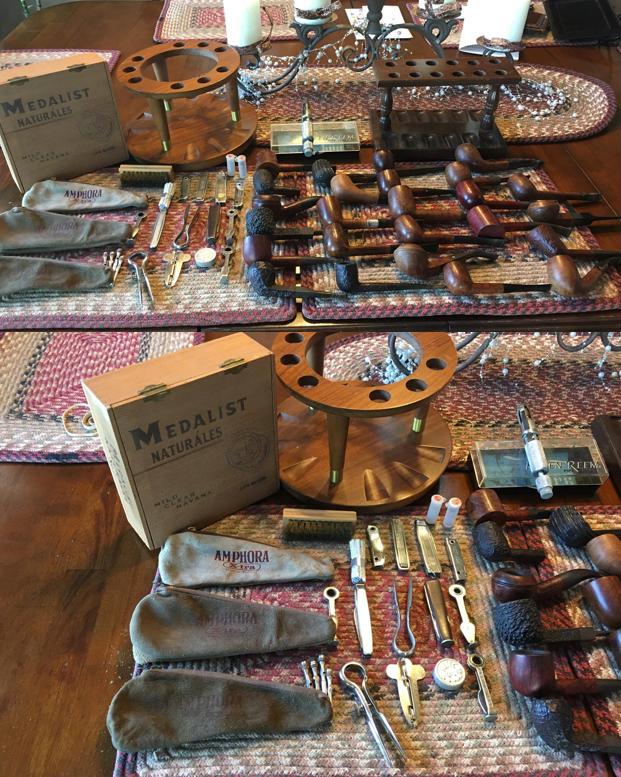


 The next pipe I chose to work on from the collection was the Dunhill Root Briar billiard that is the third pipe down in the photo above. It was in decent condition with dents and wear of the years on briar but the stem was un-oxidized. The pipe is stamped on the left side of the shank with the shape number 34 followed by F/T which is the style of stem (fish tail). I looked up the shape number on a previous blog on rebornpipes (https://rebornpipes.com/2012/11/01/dunhill-pipe-shapes-collated-by-eric-w-boehm/). The shape number 34 is a Billiard. Next to that it reads Dunhill over Root Briar. On the right side of the shank it reads Made in over England with a superscript 9 and a c. Next to that is the familiar 2 in a circle for the size of the pipe followed by a capital R for the Root Briar finish.
The next pipe I chose to work on from the collection was the Dunhill Root Briar billiard that is the third pipe down in the photo above. It was in decent condition with dents and wear of the years on briar but the stem was un-oxidized. The pipe is stamped on the left side of the shank with the shape number 34 followed by F/T which is the style of stem (fish tail). I looked up the shape number on a previous blog on rebornpipes (https://rebornpipes.com/2012/11/01/dunhill-pipe-shapes-collated-by-eric-w-boehm/). The shape number 34 is a Billiard. Next to that it reads Dunhill over Root Briar. On the right side of the shank it reads Made in over England with a superscript 9 and a c. Next to that is the familiar 2 in a circle for the size of the pipe followed by a capital R for the Root Briar finish.
This petite billiard was interesting to me in that it was a unique little Root Briar with a mystery stamping next to the Made in England stamp. The superscript underlined 9 gives a potential date of 1959 but the mystery to me is the superscript underlined c next to that. I had not seen that before on any of the Dunhill pipes that I have worked on. The finish was dirty but in decent condition and the stamping was very readable. The bowl was caked and had an overflow of lava on the rim top as well as some darkening. The outer edges of the rim had some rough spots from knocking the pipe against something hard. There was a burn mark on the front right side of the bowl and the rim top. Even through the grime and grit the amazing birdseye on the sides and cross grain on the front and back of the bowl. The stem was in excellent condition with no oxidation and some tooth chatter both sides of the stem at the button. Jeff took photos of the pipe before he cleaned it up. As usual the photos tell the story better than my words can. 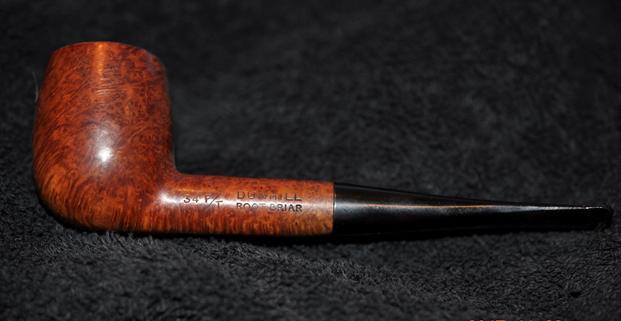

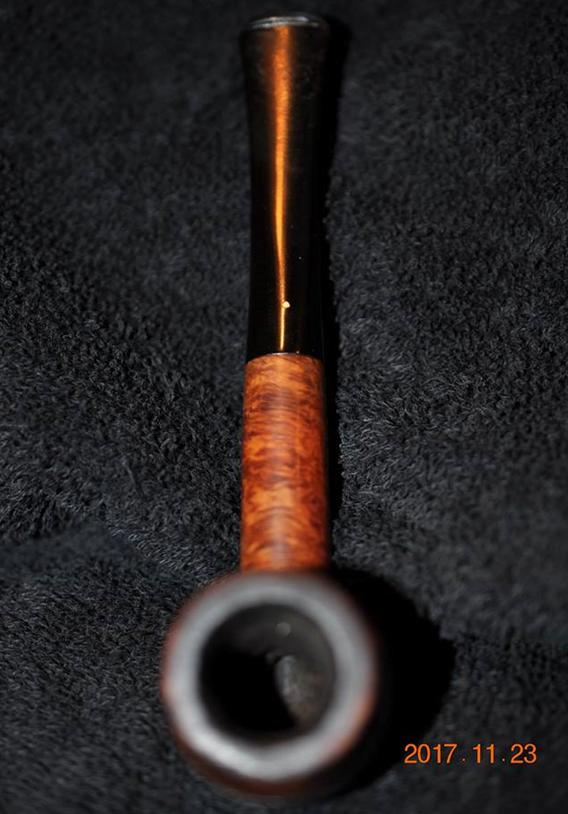 Jeff took some close up photos of the bowl and rim top to show the cake and the overall condition of the bow and rim top. Both the outer edges and inner edges of the rim show damage. The top of the rim had some lava build up and had scratches and nicks in the surface. He also took a photo of the underside of the bowl to show the grain and the small dents. It is a really nice piece of briar and should clean up well.
Jeff took some close up photos of the bowl and rim top to show the cake and the overall condition of the bow and rim top. Both the outer edges and inner edges of the rim show damage. The top of the rim had some lava build up and had scratches and nicks in the surface. He also took a photo of the underside of the bowl to show the grain and the small dents. It is a really nice piece of briar and should clean up well. 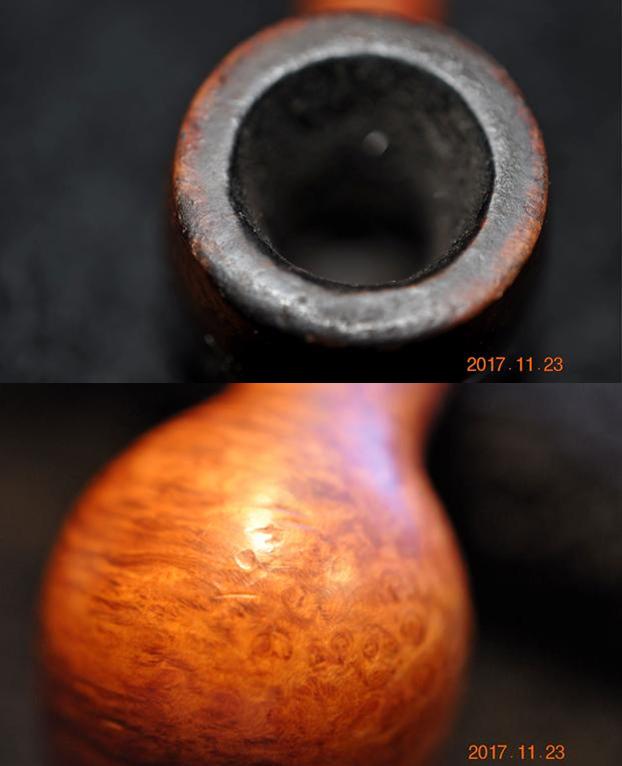 The stem was made of hard rubber and was barely oxidized as mentioned above and had tooth chatter on both sides near the button. Jeff took photos of both sides of the stem to capture their condition before he cleaned the pipe. The small white spot on the top of the stem was in good condition and slightly indented.
The stem was made of hard rubber and was barely oxidized as mentioned above and had tooth chatter on both sides near the button. Jeff took photos of both sides of the stem to capture their condition before he cleaned the pipe. The small white spot on the top of the stem was in good condition and slightly indented.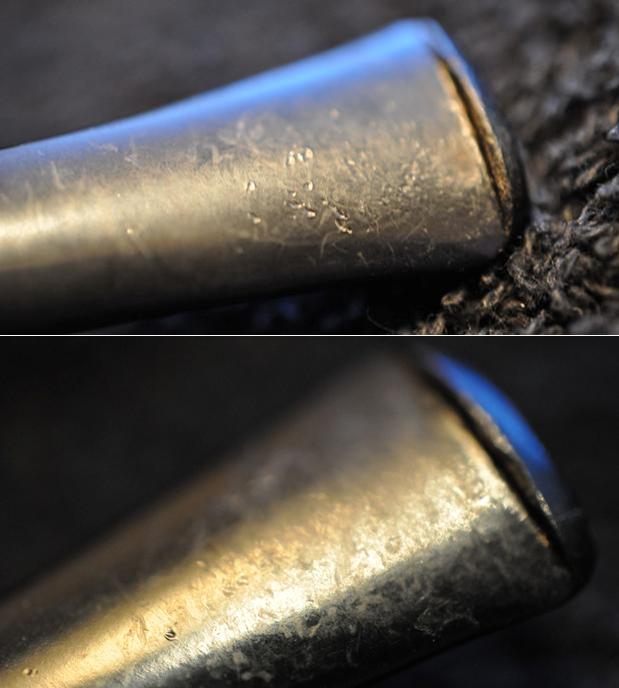
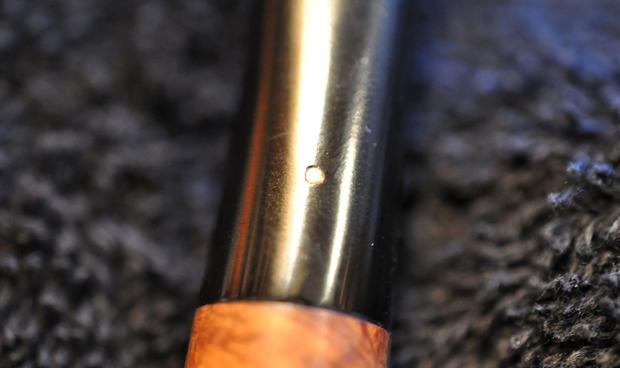 Jeff once again did his usual great job on cleaning this pipe, leaving it pristine and without damage to the finish. He reamed the bowl with a PipNet pipe reamer and cleaned up the remnants with the Savinelli Fitsall Pipe Knife. He scrubbed out the mortise and the airway in the shank and the stem with alcohol, cotton swabs and pipe cleaners. He scrubbed the exterior of the bowl, rim and shank with a tooth brush and Murphy’s Oil Soap to remove the grime of the smooth finish on the bowl and shank. He was able to remove the tars and oil on the rim but the darkening and damage to the surfaced would need to be addressed. He rinsed it under running water. He dried it off with a soft cloth. Once the dust and debris were removed the finish looked very good. He soaked the stem in Before & After Pipe Stem Deoxidizer to remove the light oxidation, rinsed it with warm water and dried it off. I took photos of the pipe to show its condition before I started my work on it.
Jeff once again did his usual great job on cleaning this pipe, leaving it pristine and without damage to the finish. He reamed the bowl with a PipNet pipe reamer and cleaned up the remnants with the Savinelli Fitsall Pipe Knife. He scrubbed out the mortise and the airway in the shank and the stem with alcohol, cotton swabs and pipe cleaners. He scrubbed the exterior of the bowl, rim and shank with a tooth brush and Murphy’s Oil Soap to remove the grime of the smooth finish on the bowl and shank. He was able to remove the tars and oil on the rim but the darkening and damage to the surfaced would need to be addressed. He rinsed it under running water. He dried it off with a soft cloth. Once the dust and debris were removed the finish looked very good. He soaked the stem in Before & After Pipe Stem Deoxidizer to remove the light oxidation, rinsed it with warm water and dried it off. I took photos of the pipe to show its condition before I started my work on it. 
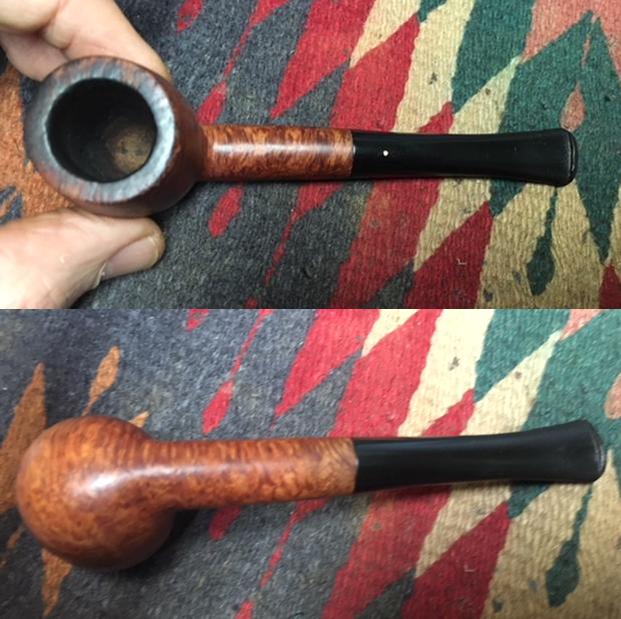 I took some close up photos of the bowl, rim top and damaged areas around the outer edge of the bowl. The front outer edge has a burn mark. The bowl was very clean and the rim top had some nicks on both the inner and outer, some scorching and general darkening. Jeff had been able to remove the lava from the finish. The inner edge had some damage and nicks and the roughness of the rim top and outer edge was visible. The stem was barely oxidized as can be seen in the photos and has tooth chatter near the button on both sides.
I took some close up photos of the bowl, rim top and damaged areas around the outer edge of the bowl. The front outer edge has a burn mark. The bowl was very clean and the rim top had some nicks on both the inner and outer, some scorching and general darkening. Jeff had been able to remove the lava from the finish. The inner edge had some damage and nicks and the roughness of the rim top and outer edge was visible. The stem was barely oxidized as can be seen in the photos and has tooth chatter near the button on both sides. Before I did and restoration work on the bowl or stem I decided to pin down the date a bit more. I knew that the pipe was made after the patent era pipes as there was no patent number on the shank but I wanted to narrow that down more. One of the beauties of Dunhill pipes is that the stamping can give you a precise date of manufacture. In this case I wanted to work on the stamping Dunhill Root Briar on the left side of the shank and the Made in England9 c on the right side of the shank. I looked up the brand on the Pipephil website as he has very helpful photos and information in dating and interpreting the stamping on Dunhill pipes. On one of the supplemental pages associated with Dunhill pipes he has a page on the Patent era pipes. I find that this page is particularly helpful when I am trying to properly identify a pipe. Here is the link to the page: http://www.pipephil.eu/logos/en/dunhill/root-briar1.html.
Before I did and restoration work on the bowl or stem I decided to pin down the date a bit more. I knew that the pipe was made after the patent era pipes as there was no patent number on the shank but I wanted to narrow that down more. One of the beauties of Dunhill pipes is that the stamping can give you a precise date of manufacture. In this case I wanted to work on the stamping Dunhill Root Briar on the left side of the shank and the Made in England9 c on the right side of the shank. I looked up the brand on the Pipephil website as he has very helpful photos and information in dating and interpreting the stamping on Dunhill pipes. On one of the supplemental pages associated with Dunhill pipes he has a page on the Patent era pipes. I find that this page is particularly helpful when I am trying to properly identify a pipe. Here is the link to the page: http://www.pipephil.eu/logos/en/dunhill/root-briar1.html.
The stamping on this one is similar to the one I am working on. Though the one I have in hand is not a DR A. The one I have is stamped 34 F/T. The Made in England marking on the pipe in the photo on the right side of the shank is similar as well. The 9 on mine is more of a superscript than this one but the underscore is the same. There is also a 1969 version that is similar but it does not have the underscore on the 9. So the pipe I have is either a 1959 or a 1969 Root Briar. What is also unique on the one I have is the superscript underlined c next to the 9. I cannot find any information on what that means.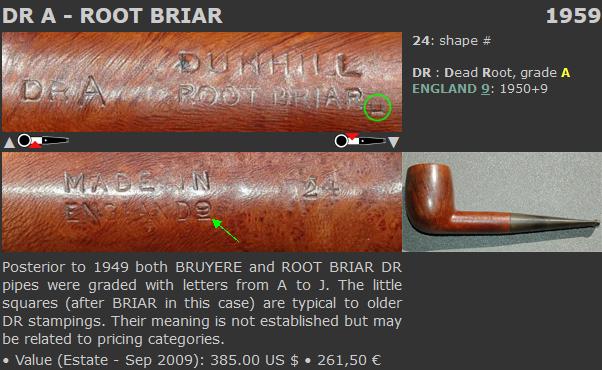 Jeff photographed the stamping on the right side the shank to show what it read and the condition of the stamping. You can see the underscored superscript 9 matches the one above. The formula is simple – the base number is either1950 or 1960 and you add the underscored superscript 9 to that number. It is either 1969 or 1959. The parallels to the photo above leads me to think it is probably a 1959 pipe. Any help on this would be greatly appreciated.
Jeff photographed the stamping on the right side the shank to show what it read and the condition of the stamping. You can see the underscored superscript 9 matches the one above. The formula is simple – the base number is either1950 or 1960 and you add the underscored superscript 9 to that number. It is either 1969 or 1959. The parallels to the photo above leads me to think it is probably a 1959 pipe. Any help on this would be greatly appreciated. To remove the damage on the rim I decided to top the bowl. I used 220 grit sandpaper on a topping board to remove the damage. I worked on it until the top was smooth and the damage on the outer edge of the bowl was minimized. I used a folded piece of 220 grit sandpaper to smooth out the damages along the outer rim. I used it to also work on the inner edge of the bowl. I gave the inner edge a slight bevel like it original had before I started.
To remove the damage on the rim I decided to top the bowl. I used 220 grit sandpaper on a topping board to remove the damage. I worked on it until the top was smooth and the damage on the outer edge of the bowl was minimized. I used a folded piece of 220 grit sandpaper to smooth out the damages along the outer rim. I used it to also work on the inner edge of the bowl. I gave the inner edge a slight bevel like it original had before I started. 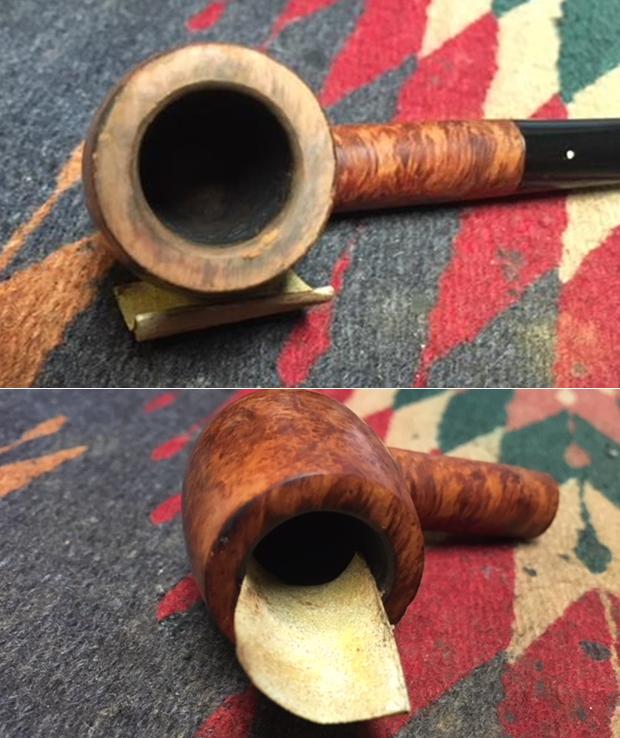 I polished the rim with micromesh sanding pads – 1500-12000 grit micromesh sanding pads. I wiped it down after each pad to check on the progress.
I polished the rim with micromesh sanding pads – 1500-12000 grit micromesh sanding pads. I wiped it down after each pad to check on the progress. 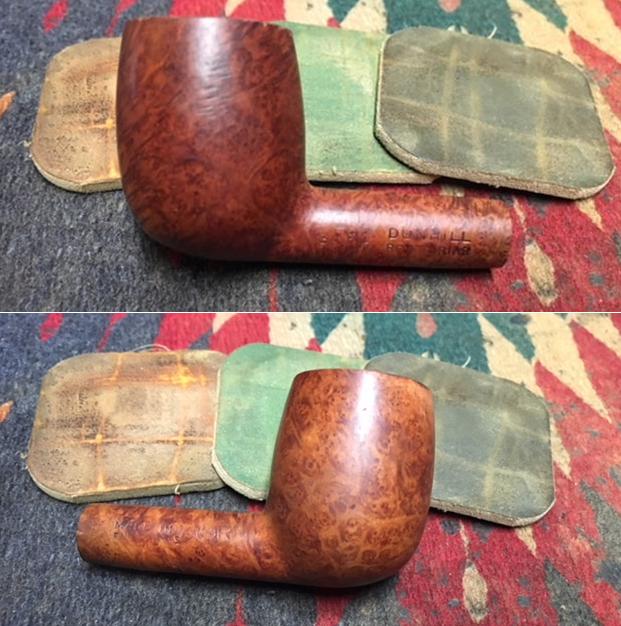
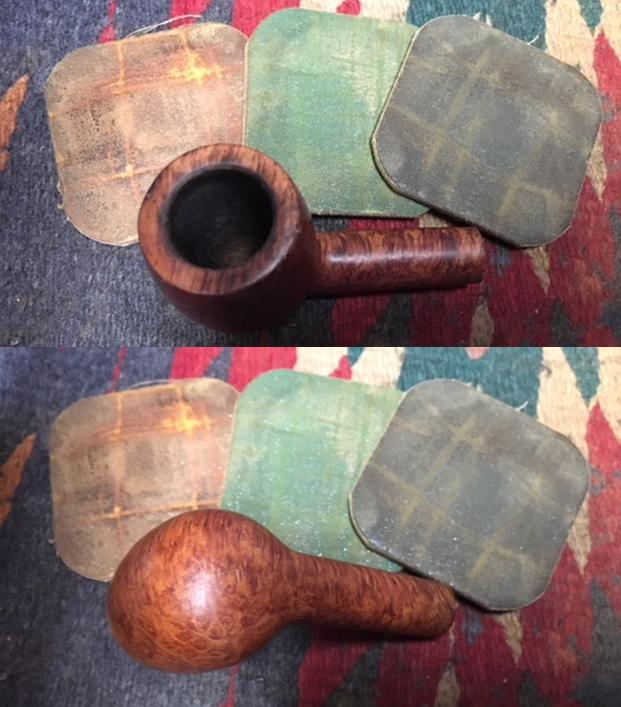
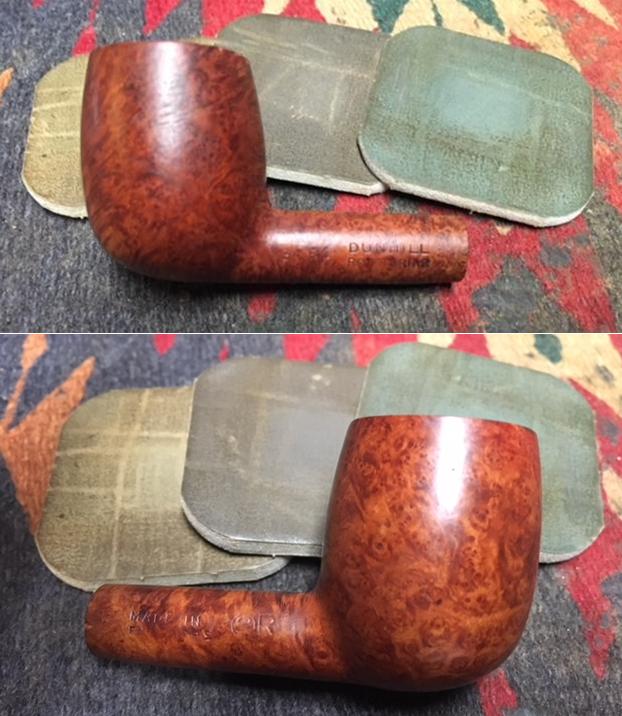
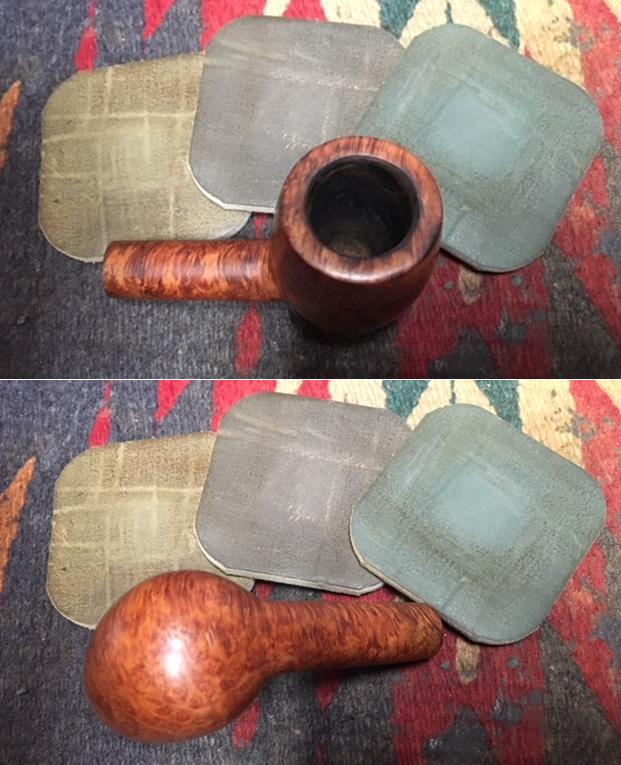
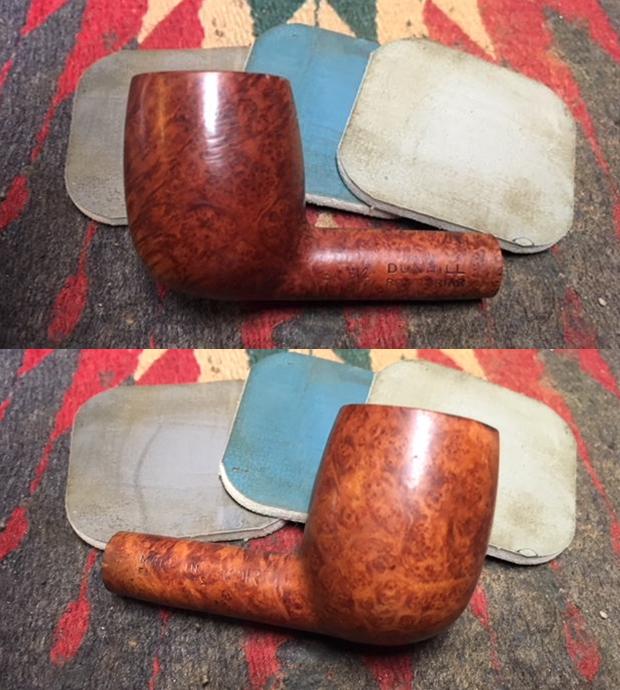
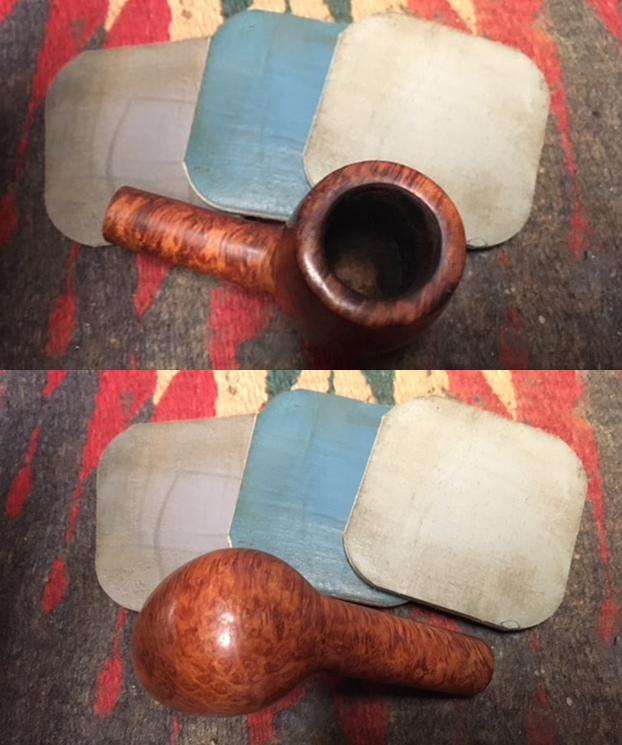 I used a maple stain pen to touch up the rim top to match the colour on the rest of the bowl. With the touch ups the rim matches the rest of the bowl colour.
I used a maple stain pen to touch up the rim top to match the colour on the rest of the bowl. With the touch ups the rim matches the rest of the bowl colour. I worked Before & After Restoration Balm deep into the briar on the smooth finish to clean, enliven and protect it. I wiped it off with a soft cloth. I buffed the bowl with a cotton cloth to polish it. It really began to have a deep shine in the briar. I took some photos of the bowl at this point to mark the progress in the restoration. The grain on the bowl is really beginning to stand out and will only do so more as the pipe is waxed.
I worked Before & After Restoration Balm deep into the briar on the smooth finish to clean, enliven and protect it. I wiped it off with a soft cloth. I buffed the bowl with a cotton cloth to polish it. It really began to have a deep shine in the briar. I took some photos of the bowl at this point to mark the progress in the restoration. The grain on the bowl is really beginning to stand out and will only do so more as the pipe is waxed.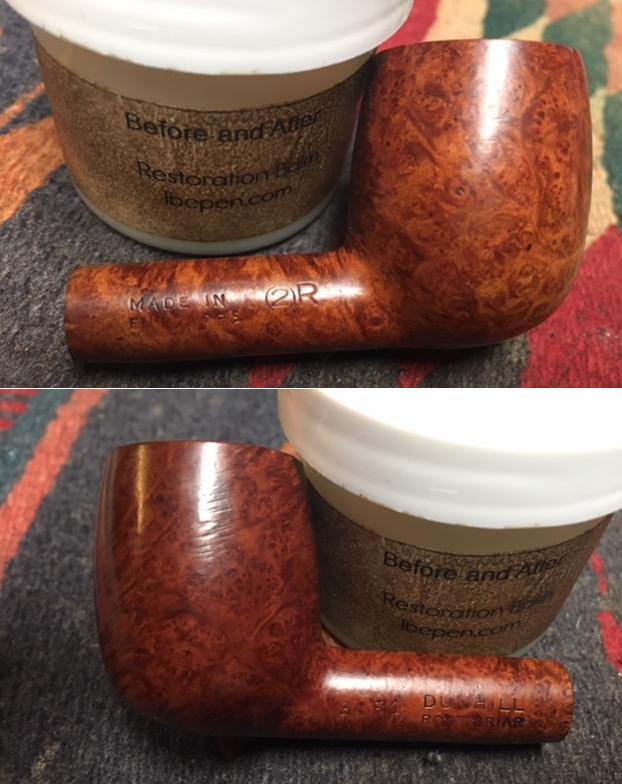
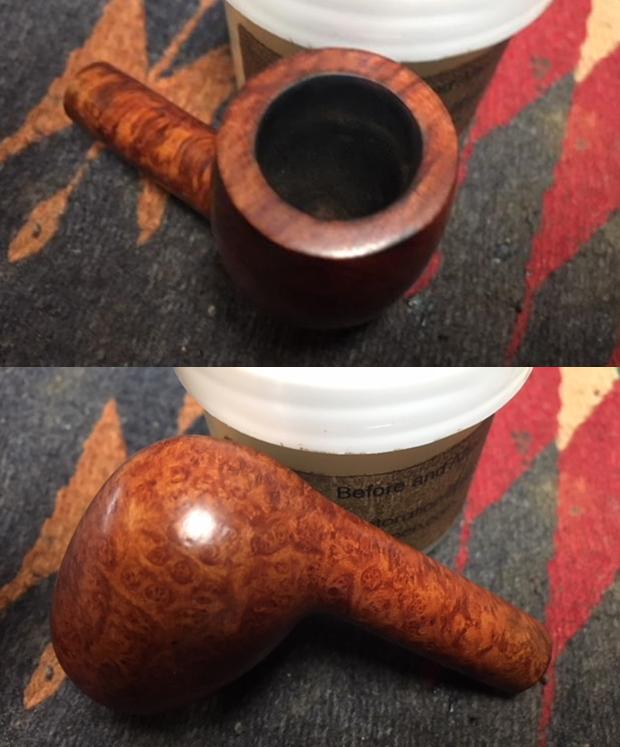 I started working on the stem next. I sanded out the tooth chatter next to the button on both sides with 220 grit sandpaper. I wiped the stem surface clean with a damp cloth. I sanded it with 400 grit wet/dry sandpaper to blend the scratches left behind by the sandpaper and blended the scratches into the surface of the vulcanite.
I started working on the stem next. I sanded out the tooth chatter next to the button on both sides with 220 grit sandpaper. I wiped the stem surface clean with a damp cloth. I sanded it with 400 grit wet/dry sandpaper to blend the scratches left behind by the sandpaper and blended the scratches into the surface of the vulcanite. 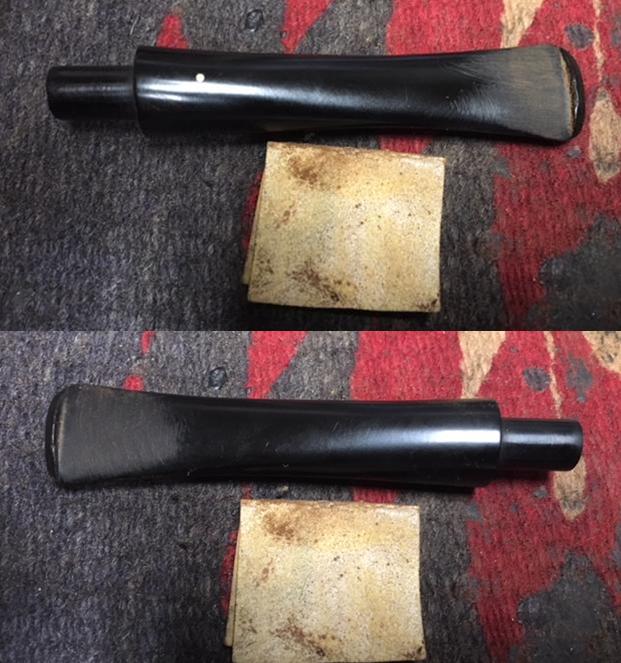
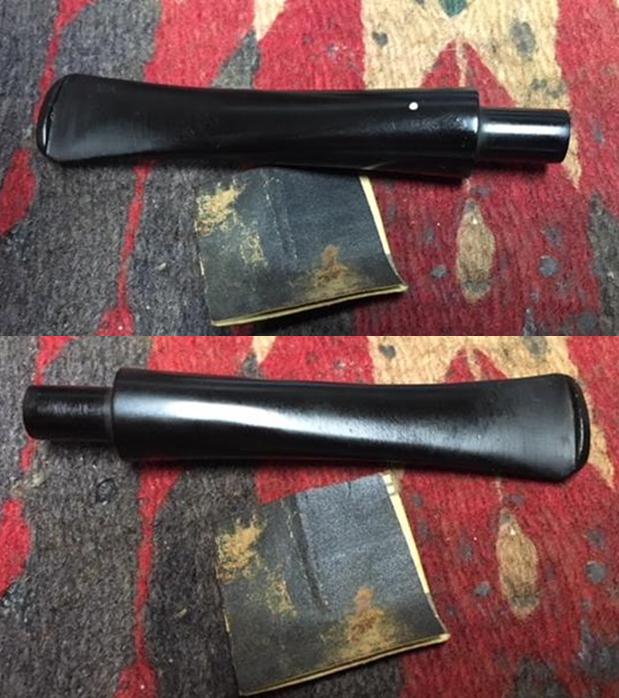 I polished stem with micromesh sanding pads – wet sanding with 1500-2400 grit pads and dry sanding with 3200-12000 grit pads. I wiped the stem down with Obsidian Oil after each pad. I polished it with Before & After Pipe Stem Polish, both Fine and Extra Fine. I gave it a final coat of Obsidian Oil and set it aside to dry.
I polished stem with micromesh sanding pads – wet sanding with 1500-2400 grit pads and dry sanding with 3200-12000 grit pads. I wiped the stem down with Obsidian Oil after each pad. I polished it with Before & After Pipe Stem Polish, both Fine and Extra Fine. I gave it a final coat of Obsidian Oil and set it aside to dry. 
 This small Dunhill Root Briar is a real beauty with straight grain on the back and front and beautiful birdseye on both sides of the bowl and shank. The grain really is quite stunning. The rim top looks much better. The Dunhill vulcanite stem is high quality and shined up well. I buffed the bowl and the stem with Blue Diamond polish to raise the shine on the briar and the vulcanite. I was careful to not buff the stamping and damage it. I gave the bowl and stem multiple coats of carnauba wax. I buffed the entire pipe with a clean buffing pad to raise the shine. I hand buffed it with a microfiber cloth to deepen the shine. The finished pipe is shown in the photos below. The rich brown stain allows the grain to really stand out on this little pipe and it works well with the rich black of the vulcanite stem. The dimensions of the pipe are: Length: 5 inches, Height: 1 1/2 inches, Outside Diameter: 1 1/8 inches, Diameter of the chamber: 5/8 inches. This little Dunhill will fit really nicely into the collection of a friend of mine, Henry who has been looking for a pipe this size. I will sending it to him soon and I know that he is looking forward to enjoying his first bowl in it. Thanks for walking through the restoration with me.
This small Dunhill Root Briar is a real beauty with straight grain on the back and front and beautiful birdseye on both sides of the bowl and shank. The grain really is quite stunning. The rim top looks much better. The Dunhill vulcanite stem is high quality and shined up well. I buffed the bowl and the stem with Blue Diamond polish to raise the shine on the briar and the vulcanite. I was careful to not buff the stamping and damage it. I gave the bowl and stem multiple coats of carnauba wax. I buffed the entire pipe with a clean buffing pad to raise the shine. I hand buffed it with a microfiber cloth to deepen the shine. The finished pipe is shown in the photos below. The rich brown stain allows the grain to really stand out on this little pipe and it works well with the rich black of the vulcanite stem. The dimensions of the pipe are: Length: 5 inches, Height: 1 1/2 inches, Outside Diameter: 1 1/8 inches, Diameter of the chamber: 5/8 inches. This little Dunhill will fit really nicely into the collection of a friend of mine, Henry who has been looking for a pipe this size. I will sending it to him soon and I know that he is looking forward to enjoying his first bowl in it. Thanks for walking through the restoration with me.







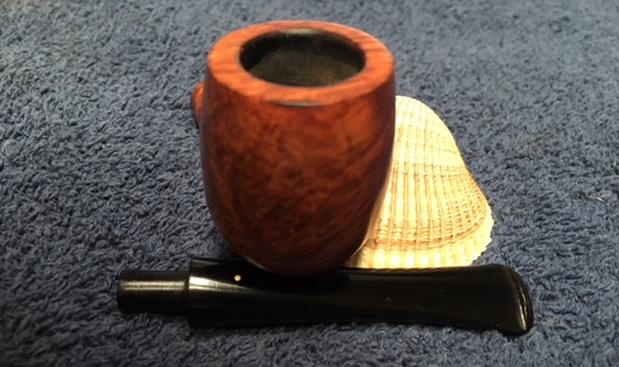


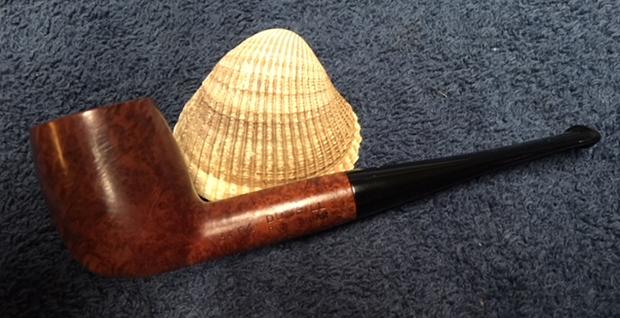
Hello!
I have the answer to the “underscored C” mystery. That is, in fact, not a letter C, but and underscored number 0 with the right side either worn down, or just poorly stamped to begin with. This pipe was made in 1959 and sold in 1960, thus the 9 stamp and the subsequent 0, which are the date codes for 1959 and 1960. Hope that helps!
S
LikeLike
Thank you for the info. I am pretty sure you are right.
LikeLike